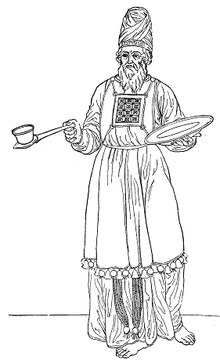Efod
Efod or Ephod ( Hebrew אֵפוֹד) denotes the liturgical robe of the high priest of the Israelites . The detailed design of the Efod is described in Ex 28.6–14 EU :
“They are supposed to make the efod as a weaver's work, from gold, violet and red crimson , crimson and twisted linen . It should have two shoulder pieces connected to one another, and at both ends they should be connected to one another. The sash on the efod is said to be of the same design and to form a single piece with it, made of gold, violet and red crimson, crimson and twined linen. Take the two carnelian stones and cut the names of the sons of Israel : six of the names in one stone and the other six names in the other, in the order in which they were born. In stone-cutting work such as engraving a seal, you are to cut the names of the sons of Israel into the two stones, and set in gold settings you are to make them. Attach the two stones to the shoulder pieces of the Efod as stones to remind the Lord of the Israelites . Aaron is to wear their names on both shoulder pieces before the Lord as a reminder. So you are to make the setting of gold and two chains of pure gold; twist them like a string and attach the string-like chains to the sockets! "
The loose bag with the loose stones Urim and Thummim was attached to the Efod with golden cords ( Ex 28.25-30 EU ).
In addition to the efod, the high priest wore the efod coat made entirely of purple ( Ex 28.31 EU ) as an upper garment, a tunic made of knitted fabric as well as a turban and belt. ( Ex 28.4 EU )
In Jud. 8.27 EU there is a passage from the Bible in which the word Efod has a completely different meaning than that of the priestly robe:
“Gideon made an efod out of it and set it up in his city of Ofra. And all of Israel practiced idolatry there. "
Compare also Ri 17.5 EU , Ri 18.14 EU and 1 Sam 19.13 EU . In this context, the word can also denote an image of a god. These images of gods do not have to be imagined as large statues in every case, as can be seen from the story in Gen. 31: 19ff. EU surrenders through Rahel , Jacob's wife, who stole his household god from her father Laban . In the nomadic world , images of gods were transportable; they functioned as the house god of the traveling clans or of the clan elder. However, an “oracle device” may also be considered.
literature
- Andreas Scherer : Tradition of religion and war. Exegetical and religious-historical studies on Judges 3-8 and related texts. Neukirchen 2005 (WMANT 105), pp. 340–347 (primarily on Richter 8) (lit.!), ISBN 3-7887-2067-0 .
